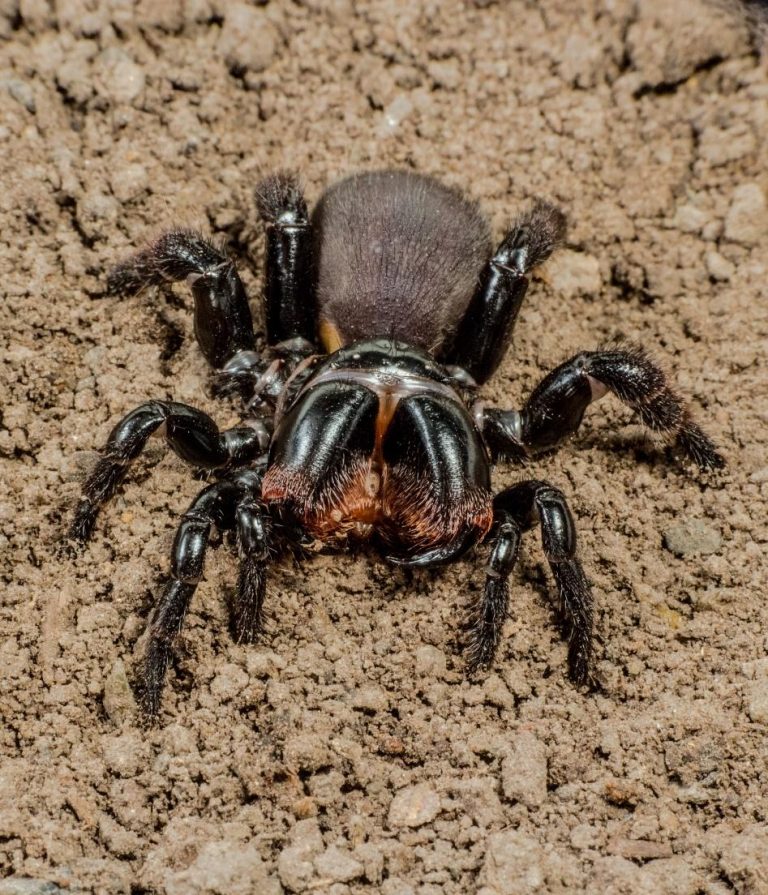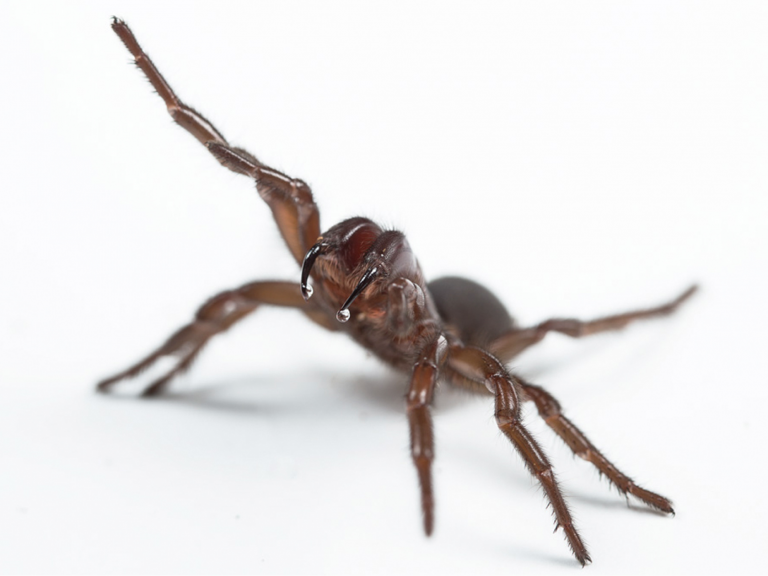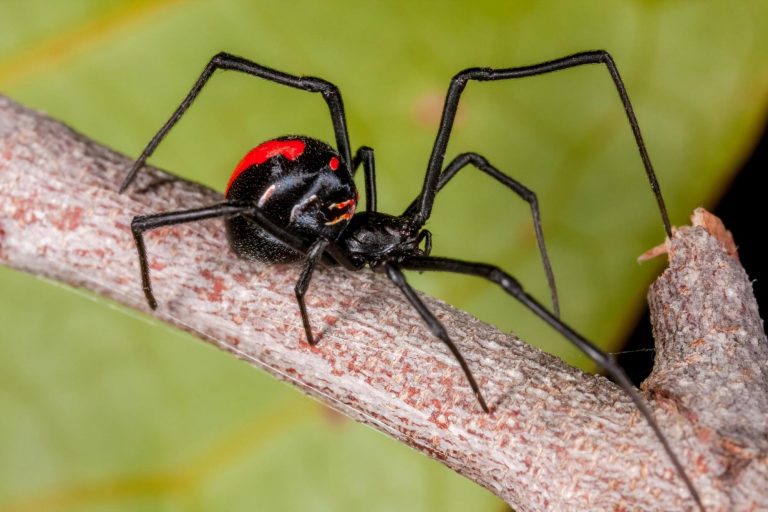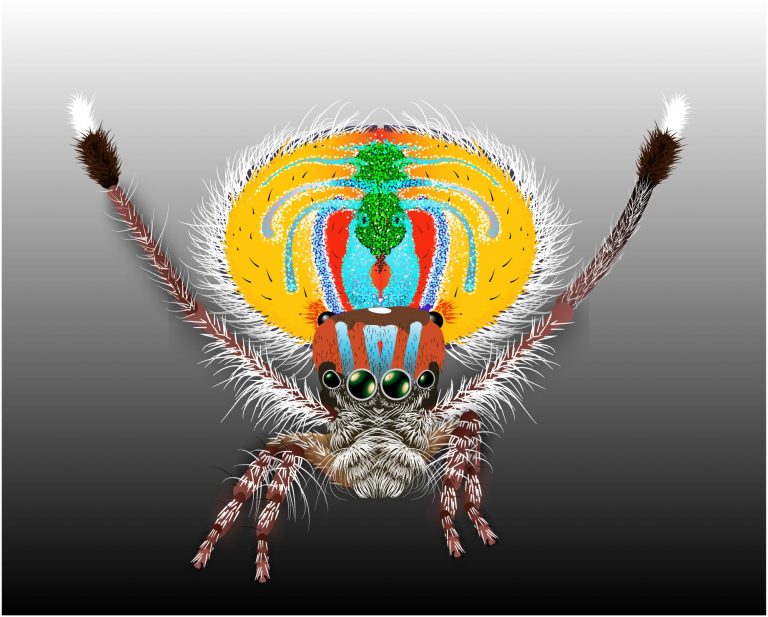Volume 3, Issue 1, March 2019
Volume 3, Issue 1, March 2019
Robert Whyte, honorary researcher of arachnology, Queensland museum. Author of “A Field Guide to Spiders of Australia”.
What do you know about Australian spiders? Do you think of them as big, hairy creepy-crawlies? Do they scare you? If you are not afraid of spiders, or maybe even are fascinated by them, you are probably in the minority. A lot of Australians suffer from arachnophobia. The fear seems to originate from United Kingdom, where people are scared literally witless by spiders, especially Australian spiders, often trumpeted as ‘the world’s most deadly’.
Why is this so? In Great Britain they don’t have any seriously dangerous spiders. What are they so worried about?
Fear of spiders in Great Britain is really fear of the unknown, because British people, by and large, are totally ignorant about spiders. If they took an interest in spiders and studied them, they would lose their fear forever.This is because knowledge and familiarity of spiders cannot co-exist with fear of spiders. Arachnophobia is an anticipatory fear, a fear about what might happen. When you get to know spiders, you learn they aren’t the imaginary huge things in tunnels like in Harry Potter or Lord of The Rings. You discover they are small and generally harmless and much less dangerous than bees or ants.
It is true that in Australia we do have spiders which are called “medically important” because of their venom, but we now know medical care prevents serious harm. In fact, even the potentially deadly Sydney Funnelweb has not been responsible for any deaths since 1979.It’s just a matter of keeping calm and treating the symptoms and you’ll be fine.
The amazing thing about this type of phobia (of spiders or snakes, cockroaches, frogs or clowns) is that it is caused by parents. Yes, parents, sisters, brothers, aunts, uncles or even teachers and schoolfriends can pass on this fear when they make this face (Figure 1) from Charles Darwin’s The Expression of the Emotions in Man and Animals (1872).
Once the fear is switched on in an infant, the child avoids the feared object, naturally enough. Over time with repeated avoidance, the fear gets stronger and develops into a fully-blown phobia. This can cause nightmares, panic, and even possibly death, as we shall see later.
Humans aren’t born with these fears, but they can be triggered for spiders, snakes and other classically scary things like scorpions more easily than they can be triggered by flowers or rabbits. However, experiments with the fear face and pictures of flowers or rabbits have shown the fear face can make young monkeys develop a flower phobia (anthophobia) or a rabbit phobia (leporiphobia). The fear face is powerful, and very dangerous if used with evil intent.

Figure 1: The “fear face” is an unconscious (and rather unattractive) expression which appears on a mother’s face when she sees her child picking up a spider. The child drops the spider instantly, because the face triggers the deeply embedded fear reaction “Drop it! Get away!” Spider and snake fear are two of the easiest to “turn on”. Source: “Terror”, from a photograph by Dr. Duchenne, Wikipedia
The authorities don’t allow scientists to try to induce fears of flowers or rabbits in young humans, but history shows many irrational fears have developed in children and persisted into adulthood. For example, a fear of buttons (koumpounophobia). Steve Jobs, co-founder of Apple, suffered from koumpounophobia, which may be why iPhones have touchscreens instead of physical buttons like older phones.
Evidence that humans do not have an innate fear of spiders, just a predisposition for it to be triggered, is seen in those countries where people eat spiders. Yes, just fry up a tasty spider snack. Fried spider is a regional delicacy in China, Thailand and Cambodia, especially the town of Skuon where fried spiders are a popular attraction for tourists passing through. In Mexico, tarantulas have been offered in tacos, with a splash of guacamole.
In many human cultures, people eat insects, grubs, and worms. Eating creepy crawly things is, in fact, the norm, not the exception. In these cultures, no one goes around making the fear face at children when they see any of these things.


Figure 2: Which is scarier? The Mouse Spider Missulena bradleyi on the left, or the 12 daisies on the right. You choose.
Page: 1
Once a fear of spiders is passed down by generations of mothers to their children, it can become an epidemic. Great Britain’s lack of dangerous spiders and ignorance on the topic of spiders makes it worse. They have no human-spider associations to cure the fear. Australian arachnophobes are cured instantly when they allow the harmless female Golden Orb-weaver Nephila spp.to walk on their hands. This has been demonstrated hundreds of times by leading spider expert, Dr Robert Raven, at Queensland Museum. Dr Raven, as it turns out, was arachnophobic as a child and decided he needed to get rid of this irrational and unhelpful fear, which he did by becoming a spider expert.
What is Australia’s most dangerous spider? Most people would say the Sydney Funnelweb, the Australian Redback or the White-tailed Spider.
The last of these, the White-tailed Spider Lampona spp. is in fact harmless and the stories of it causing ghastly necrotic ulcers are just bogus. It’s not only an Internet myth, it’s a medical myth, because it started with a misdiagnosis by a leading medical professional. Moreover, if medicos perpetuate this myth, which is still very much alive, they risk missing potential serious bacterial infections, including gangrene, which are usually the real causes of necrotic ulcers.
So what about the Sydney Funnelweb and the Redback? Well, there’s no doubt that the Sydney Funnelweb, which only occurs within a 100km radius of Sydney, is a potential lifetaker. If you were wearing a spacesuit with a Sydney Funnelweb in it, and it bit you, and your tether to the space station broke and you drifted off into space without being rescued, you would almost certainly die.
But probably not from the Funnelweb bite. More likely, you would run out of oxygen before the Funnelweb venom got you.
The simple truth is no deaths have occurred because of Funnelweb bites since 1979. This was a full two years before the antivenom was developed. The anti-venom works by stopping the “lung frothing”.
This doesn’t mean you should fool around with large glossy-black spiders wandering on a rainy summer night in search of a female. Any spider looking even remotely like this is to be avoided. Even if you think it is dead, do not pick it up. It probably isn’t – even if it is lying at the bottom of a swimming pool. These spiders can go into suspended animation in water for days at a time.

Australians often ask if they get Funnelwebs where they live. The answer is, probably, yes. While the Sydney Funnelweb Atrax robustus is restricted to around Sydney, there are about 35 other species of Hexathelidae (Australian Funnelweb Spiders) considered medically important. They range across eastern Australia. Another family, the Mouse Spiders Actinipodidae, ranges Australia-wide. It is often found in drier areas, especially the spectacular Red-headed Mouse Spider. Their venom is similar to the Funnelwebs and fortunately, the funnelweb anti-venom is effective for these spiders too.
In the unlikely event you or someone else does get bitten, the first aid is simple. Apply a pressure bandage to the site of the bite and call an ambulance. It’s as easy as that.
We know now that not all anti-venoms are equal. The Redback anti-venom, in use since 1956, is entirely useless, unless you consider the placebo affect it might have. When administered by intramuscular injection, the anti-venom simply does not get into the bloodstream in order to counteract the venom. It works in a test tube (“in vitro” as they say) but unfortunately, we don’t live in test tubes. When administered intravenously (into the blood stream) it doesn’t work either. Why not? Because the effect of the venom is to shred the membranes of your nerves at the bite site and it only takes seconds to do its work. The anti-venom simply doesn’t get there in time.
The most obvious sign of a bite from a redback spider is extreme pain accompanied by localised sweating, beginning three to five minutes after being bitten. The sweating then becomes more generalised. This is the result of the body reacting to its own leaking brain chemicals. Feeling sick, abdominal pain and nausea can be brought on by trauma and associated pain. If bitten, call an ambulance and stay calm. Do not apply a pressure bandage.
It might seem rather a pity that Redback anti-venom has never worked, but there is an up-side. Given that it has never worked since it was introduced more than 60 years ago, what has stopped people dying of Redback bite? The simple fact is that the venom is not deadly. It is excruciatingly painful, so much so that you might wish you were dead, but deaths prior to 1956, logic tells us, must have been the result of medical misadventure. Administering the anti-venom since 1965 has at least prevented more dangerous medical procedures.

Figure 4: Redback Spider Latrodectus hasselti Source: Photo © Greg Anderson, A Field Guide to Spiders of Australia, CSIRO Publishing 2017
Of special interest to South Australians, the Redback Spider’s original natural range was a relatively small part of arid north-west South Australia and adjacent parts of Western Australia. After the Redback Spider made it to Adelaide and hitched a ride on boats to the eastern states, it spread quickly. It has now been recorded in all parts of Australia, New Zealand, Japan, England, Belgium, Iran and the Philippines, all originating from its small population in the remote outback.
As for other possible dangerous spiders, the urban myth that Daddy Long-legs have the most potent venom known and humans are only spared by the smallness of the fangs is not even worth considering, it is so silly. The venom is in fact not powerful, and the tiny fangs (about 0.25 mm) are capable of piercing human skin as shown on Mythbusters. The stinging sensation produced was very short-lived. There was no further discomfort. What’s more, these common household spiders are our allies – they can kill redback spiders by injecting venom into the soft, unprotected joints in their legs.
The introduced Brown Recluse or Fiddleback Spider, Loxosceles rufescens, is becoming widespread and common in South Australia (from an original small and thought-to-be harmless population in Adelaide). Although most Loxosceles spider bites are unremarkable with no serious medical complications, they can occasionally cause necrotic (flesh-eating) wounds with long healing times and sometimes severe illness. To be fair, ulcerating lesions can have a wide range of causes and mostly they are not the result of Brown Recluse Spider bite, even in South Australia. It seems the Fiddleback Spider is reluctant to bite people, because no recent cases have been reported.
Now we come to the only Australian spider which might be implicated in recent deaths, or at least severe bodily injuries, not to mention damage to property. This is everyone’s boogie creepy-crawlie, the lightning-fast Huntsman. This spider is very large and often startling because of its sudden, unpredictable movements.
Imagine you are on a ladder, cleaning out leaves from the gutters of your house. Suddenly you disturb a Huntsman Spider and like an arachnological version of The Flash, it races over your hand, up your sleeve, inside your shirt, out your collar and up onto your head via the back of your neck. Scary, huh?
If you have a panic reaction, or to be more precise, fail to suppress your very natural panic reaction, you could be in big trouble. Arms flailing about and jumping up and down is not something you want to be doing on a high ladder. Just calm down, hang onto something solid, take a deep breath and wait. The Huntsman will soon move on. Just wait until you are perfectly calm, then climb down slowly and carefully to the ground. Once there you can run around screaming all you like.
The same goes for Huntsman Spiders leaping out from behind the car’s sun visor onto your chest. If you are travelling at speed, panicking could be fatal, not only to you, but to anyone else in your path. Being arachnophobic is definitely not an advantage in this situation. We know of serious accidents caused by Huntsman spiders.A surprise Huntsman was the reason behind a multi-car pile-up in Blaxland, in 2017, which saw five adults and two children taken to hospital. Four cars were involved in the crash at the intersection of Leyton Avenue and the Great Western Highway. The spider fell from the interior roof onto a 65-year old Fairfield male driver resulting in a wild swerve into the westbound lane of the highway colliding with a car being driven by a 39-year-old Winmalee man, which spun out of control hitting two other cars. The multi-car pile-up left 11 injured.
In 2016 a Lake Cathie man was driving to the local garbage depot to dispose of his spring-cleaning clutter when a Huntsman hopped onto his arm. He slammed on the brakes, but missed, unfortunately flattening the accelerator, causing him and his car to careen into the lake, narrowly avoiding nearby trees.
How many fatal crashes have happened where the accident victims did not survive to blame the spider? Who knows? However many, it is simply not the spider’s fault.It is people’s fear and unfamiliarity of spiders which is to blame. An experienced bushie, arachnologist or just about anyone from tropical North Queensland would be calm and controlled, negotiating the incident without harm.
Let’s face it, Australian spiders have a bad rep – most of it unearned and undeserved.Even Funnelwebs won’t hurt you unless you provoke them.
The antidote? Become interested, knowledgeable and familiar with spiders.Spend some time with the macro setting on your camera in your garden. You’ll be amazed what you find. See if you can identify them. Why not join a biodiversity app like Questagame? You’ll find most Australian spiders are tiny, intricately arranged and very pretty, thriving in parks and gardens in their millions, catching insects.
Australian Jumping Spiders are arachnological rock stars, with mainstream media breakthroughs, YouTube hits, front-page newspaper stories, TV features and countless macro photographs. Jürgen Otto’s recently named Peacock Spider Maratus personatus was dubbed the world’s cutest spider by online magazine The Verge, while Jürgen’s popular video of Maratus speciosus has had more than 7,400,000 views.Peacock Spider courtship displays feature a complicated ritual of leg waving, toe-tapping and abdomen twerking. Most have brilliantly coloured side flaps they extend like peacock tail feathers to mesmerise their mates. Just jump onto YouTube and see for yourself.One of most outrageous is the video cut to the Village People song YMCA.
Staying safe: “Become interested, knowledgeable and familiar with spiders”

Figure 5: Drawing of a male peacock spider engaged in a courtship display. Source: CC by KDS444 from Wikimedia Commons
Page: 2
Group activities
1. In groups, visit a nearby space with foliage of trees and shrubs and count the number of spiders you can see. Try to identify them with A Field Guide to Spiders of Australia, CSIRO Publishing 2017 (available in libraries).
2. Spiders can be interesting and unusual. In your group, each choose a species and give the class a two-minute presentation on the facts and features of the species and how safe they are for humans.
3. Stage an event in which someone sees an imaginary huntsman spider in their house, garden or car and reacts in several different ways. Ask your class to vote on which is the most sensible response.
4. Which spiders are harmful to humans and what measures can you take to avoid being bitten?
5. Describe what you would do if you or someone else is bitten by (a) a funnelweb, (b) a redback spider.
6. Venoms and toxins are especially important in certain careers. Find out which careers are involved and why. Each group should choose one career path and explain it.
7. See how many spiders you can identify in a given area over a certain period time, like 6 months.
8. Do a comparison on how many spiders you can see in a disturbed habitat compared to a rich natural habitat.
Multiple choice
Spiders have eight legs.What are they used for?
A. | To scare people |
B. | To scare other spiders |
C. | To swim across oceans |
D. | To move about on almost any surface |
Which substance in most spiders is injected when they bite?
A. | Venom |
B. | Anti-venom |
C. | Saliva |
D. | Spiders don’t inject anything, they extract blood |
Which response is correctly matched to its event?
Take your shoes off and put them in a rubbish bin. |
Stay calm and call an ambulance. |
Close your eyes and run screaming. |
Get in the spaceship and travel out of the solar system. |
Which response is correctly matched to its event?
A. | Accidentally treading on a spider. |
B. | Being bitten by a venomous spider. |
C. | Seeing a spider on the wall. |
D. | Seeing a spider on Mars. |
Which of the following spiders are medically important?
A. | Sydney Funnelweb Spiders. |
B. | Cute Peacock Spiders. |
C. | Harmless Spiders. |
D. | Spiders more than two metres tall. |
Phobias are important and sometimes debilitating.Why?
A. | They prevent people from getting passports and other travel documents. |
B. | They can interfere with people’s ability to do normal things. |
C. | They can prevent you from being scared of anything. |
D. | They make you feel euphoric and giggle all the time. |
Fear of spiders (arachnophobia) is passed from adult to child by what mechanism
A. | Spider telepathy. |
B. | Human telepathy. |
C. | The adult making the b fear faceb. |
D. | A virus. |
In the world what invertebrate animal causes the most deaths?
A. | Mosquitos. |
B. | Spiders. |
C. | Frogs. |
D. | Lions. |
What can cure Arachnophobia?
A. | Becoming interested, knowledgeable and familiar with spiders. |
B. | Hating and avoiding spiders. |
C. | Induced coma. |
D. | Aromatherapy with garlic. |
Some things can trigger phobias with the “fear face” more easily than others.Which of these is the least likely to trigger a phobia.
A. | Spiders. |
B. | Snakes. |
C. | Cockroaches. |
D. | Self-raising flour. |
What could be the benefit of triggering a fear of spiders or snakes?
A. | Lifelong nightmares. |
B. | Causing a child to immediately drop a potentially dangerous animal. |
C. | A feeling of joy and peace. |
D. | A sudden realisation that you know everything. |
Why is it better to be interested, knowledgeable and familiar with spiders?
A. | So you can train them to do acrobatic tricks on the flying trapeze. |
B. | You will minimise the chance of having a blind panic reaction. |
C. | You can easily get the highest marks in any exam you do. |
D. | You will be able to change the colour of your hair by willpower. |
What spider causes the most traffic accidents in Australia?
A. | Huntsman Spiders. |
B. | Invisible Spiders. |
C. | Imaginary Spiders. |
D. | Cute Peacock Spiders. |
Which of the following spiders was unfairly blamed for causing flesh eating wounds
A. | The White-tailed Spider. |
B. | The Black-tailed Spider. |
C. | The Grey-tailed Spider. |
D. | The spiders whose tail is indeterminate in colour. |
Where does the Sydney Funnelweb Spider naturally occur?
A. | In England. |
B. | On Mars. |
C. | At the Melbourne Cricket Ground. |
D. | Within a hundred km radius of Sydney. |
How could the Sydney Funnelweb Spider cause death if a bite was left untreated
A. | Pulmonary oedema. |
B. | Nervous collapse. |
C. | Panicking and jumping off tall buildings. |
D. | Dying of thirst. |
Page: 3